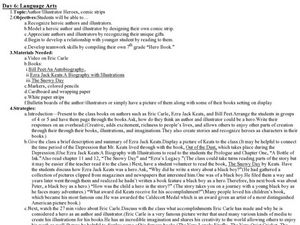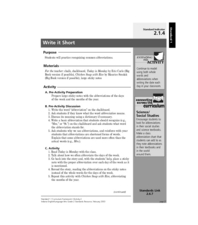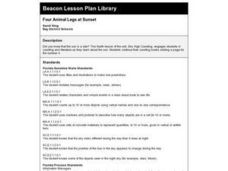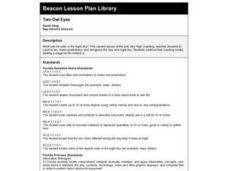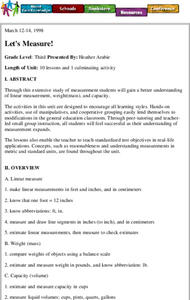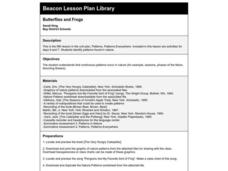Curated OER
Colors, Colors What Do You See?
Students study their colors by reading a book Brown, Bear, Brown Bear and take pictures of colors. In this color recognition lesson, students read the book and sing a song about colors. Students then take pictures of various colors using...
Curated OER
Going Buggy!
Students study bugs over a four week period. In this insect collection of activities, students observe insects covering basic science concepts and skills, such as classification, observation, and responses to habitat. Students develop...
Curated OER
Author/Illustrator Heroes
Students recognize heroic authors and illustrators and create their own comic strips. In this language arts lesson, students examine characteristics of heroes and work in groups to create their own comic strips and hero books.
Curated OER
Cool Math
Young scholars benefit from the correctly selected book for a specific math concept. In this book selection lesson, students are given a list of books related to specific math concepts. Young scholars' ages can range from pre-school to...
Curated OER
Write It Short
Learners listen the books, "Today Is Monday," "Chicken Soup with Rice," and discuss how we use abbreviations for days of the week. This simple lesson plan is a good way to introduce the common abbreviations that young readers will...
Curated OER
Secret Stories: Exploring the Elements of Folktales and Fables
Students are introduced to the characteristics of fables and folktales. In groups, they read and identify the various elements in the stories they read from around the world. For each story, they analyze the setting and the various...
Curated OER
Pattern Detectives
Students discover patterns in language, math and science. They experience patterns by hearing stories, and becoming pattern detectives.
Curated OER
Four Animal Legs at Sunset
First graders listen to the book, 1, 2, 3, To The Zoo, and focus on the one-to-one correspondence while counting the animals and other objects in the story. They create page number four in their number books.
Curated OER
Two Owl Eyes
First graders listen to the story, Olivia Counts, and demonstrate counting to ten. They make predictions, and recognize the day and night sky. They add page number 2 to their counting books.
Curated OER
Let's Measure
Third graders practice measuring different objects. They discover the concepts of ratio and proportion and practice converting numbers into the correct unit. They read stories as well to help them with the concepts.
Curated OER
Sunflowers, The Circle of Life
Young scholars investigate and observe plants and animals in nature. They find out how life cycles are present in much of nature. Students use appropriate graphic organizers for information gathering. Young scholars use sequence life...
Curated OER
Planting Phil's Garden
Students study how to care for plants. In this plant care lesson, students observe a plant care demonstration and examine flowers using their senses. They listen to Janet Wakefield's, What If Everybody Gave? They complete a community...
Curated OER
Planting Phil's Garden
Students explore gardening. In this agriculture lesson plan, students plan and plant seeds according to the procedure modeled by a "master gardener." Flowers are distributed at a local retirement home.
Curated OER
Moving with the Marigolds
Students identify the basic needs and purposes of flowers. They differentiate between wants and needs of people. They participate in trust building exercises. They role play the movements of flowers.
Other popular searches
- Eric Carle Lesson Plans
- Eric Carle Author Study
- Eric Carle Books
- Eric Carle Illustrations
- Children's Books Eric Carle
- Eric Carle Website
- Eric Carle Brown Bear
- Eric Carlee
- Eric Carle Lessons
- Eric Carle Grouchy Ladybug
- Eric Carle Red Fox
- Eric Carle Ladybug




